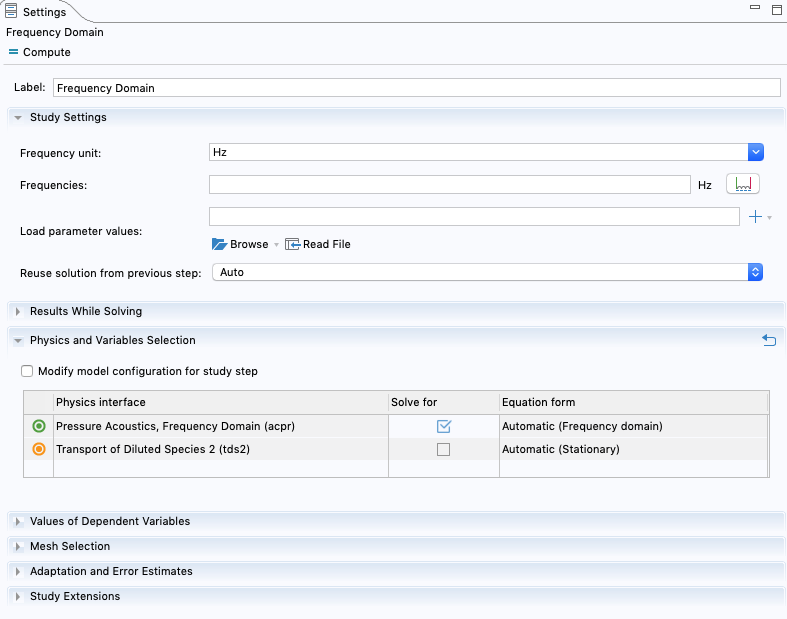Please login with a confirmed email address before reporting spam
Dear Mark, thank you very much for your quick answer.
In fact, it is not a Poisson equation but a "Transport of a dilute species", that I want to solve with a stationary equation, coupled with the "Pressure acoustics" frequency domain (sorry I should have said that directly...)
When you try to set this up in your model, do you encounter any specific error message or issue? I wonder if it is more related to how you specify the manual coupling rather than the solver configurations.
The problem arises when I add the frequency domain solver (which you suggest might also solve the transport equation or whichever stationary problem). This is what I get :

As you can see, Transport of diluted species is unchecked (and uncheckable) because COMSOL considers that it cannot be solved with a frequency domain solver despite, as you mentioned :
Frequency Domain interface does use a Stationary Solver (this can be seen in the solver configurations)
I had the same remark and wondered whether I could build by myself some "weird study" including a stationary solver, but I don't have even any clue on how to compile both equations.
I wonder if it is more related to how you specify the manual coupling rather than the solver configurations.
The sound velocity in pressure acoustics depends on N, the solution of the transport equation and the convection velocity in the latter depends on abs(p), the local peak pressure amplitude. All the coupling is made through a list of variables.
Thank's very much again.
Best regards,
Olivier.
Dear Mark, thank you very much for your quick answer.
In fact, it is not a Poisson equation but a "*Transport of a dilute species*", that I want to solve with a stationary equation, coupled with the "*Pressure acoustics*" frequency domain (sorry I should have said that directly...)
>When you try to set this up in your model, do you encounter any specific error message or issue? I wonder if it is more related to how you specify the manual coupling rather than the solver configurations.
The problem arises when I add the frequency domain solver (which you suggest might also solve the transport equation or whichever stationary problem). This is what I get :

As you can see, *Transport of diluted species* is unchecked (and uncheckable) because COMSOL considers that it cannot be solved with a frequency domain solver despite, as you mentioned :
>Frequency Domain interface does use a Stationary Solver (this can be seen in the solver configurations)
I had the same remark and wondered whether I could build by myself some "weird study" including a stationary solver, but I don't have even any clue on how to compile both equations.
> I wonder if it is more related to how you specify the manual coupling rather than the solver configurations.
The sound velocity in pressure acoustics depends on N, the solution of the transport equation and the convection velocity in the latter depends on abs(p), the local peak pressure amplitude. All the coupling is made through a list of variables.
Thank's very much again.
Best regards,
Olivier.

